At the heart of every organization’s strategy is a desire to combine the work of addressing everyday challenges with an ability to raise its perspective and identify the overall way forward. However, daily problem-solving takes over in many organizations, and long-term strategic work gets neglected.
What is Hoshin Kanri
Hoshin Kanri, commonly known as Strategy or Policy Deployment, is a management process that aligns an organization’s functions and activities with its strategic objectives, both vertically and horizontally.
It involves developing a specific plan (typically annual) with precise goals, actions, timelines, responsibilities, and measures [1].
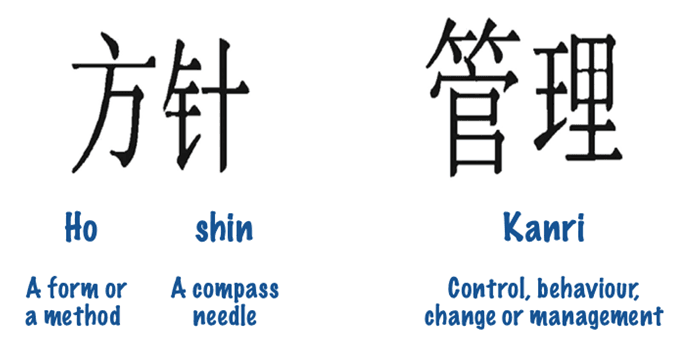
History of Hoshin Kanri
In the field of strategy development and implementation, several management methods and procedures have evolved and coexisted over the past 60+ years:

Hoshin Kanri originated in Japan and has been tested in large organizations, including Toyota, Procter & Gamble, Hewlett Packard, and Xerox, for almost 60 years.
The Japan Association of Service and Technology, along with Dr. Deming, first studied its principles in the 1950s. In 1954, Peter Drucker published “The Practice of Management,” introducing Management By Objectives (MBO), which heavily influenced Japanese strategic management practices.
In the 1960s, Bridgestone Tire Company, in its quest to understand the techniques and operating processes used by companies that won the Deming Prize, studied all the strategic aspects companies needed to win. It enhanced and combined them into what is officially called the Hoshin Kanri approach.
In the late 60s, post-war Japan saw significant advancements in quality management, closely linked with Hoshin Kanri practices. By the 70s, Hoshin Kanri was more widely adopted in Japan, including integration into the Toyota Production System.
In the late 1970s and during the 1980s, Hoshin Kanri spread to large American corporations like Procter & Gamble, Hewlett Packard, and Xerox.
Yoji Akao, widely recognized as the developer of Hoshin Kanri, published a book in 1987 that was translated into English in 1991, promoting a wider understanding and application of the methodology.
The negatives that Hoshin Kanri seeks to address
Hoshin Kanri is based on the principle that the most powerful organizations are those that have managed to harness the creative-thinking power of all their employees.
In an ideal scenario, employees clearly understand and are aligned with the organization’s vision and goals. They are seen as experts in their jobs, and their contributions are recognized.
Unfortunately, most organizations are a long way from this.
Employees receive little to no training, there is a lack of clarity on roles and purpose, and goals are often vague or subjective and left to interpretation. Managers struggle to understand while perceptions vary widely from person to person.
The resulting confusion leads to serious underachievement compared to the organization’s potential capabilities if everything were aligned.
For most of corporate history, organizations evolved with departments operating as independent fiefdoms [4]. This means they have strong vertical fibers but are very poor horizontally, leading to considerable conflict and sub-optimization:
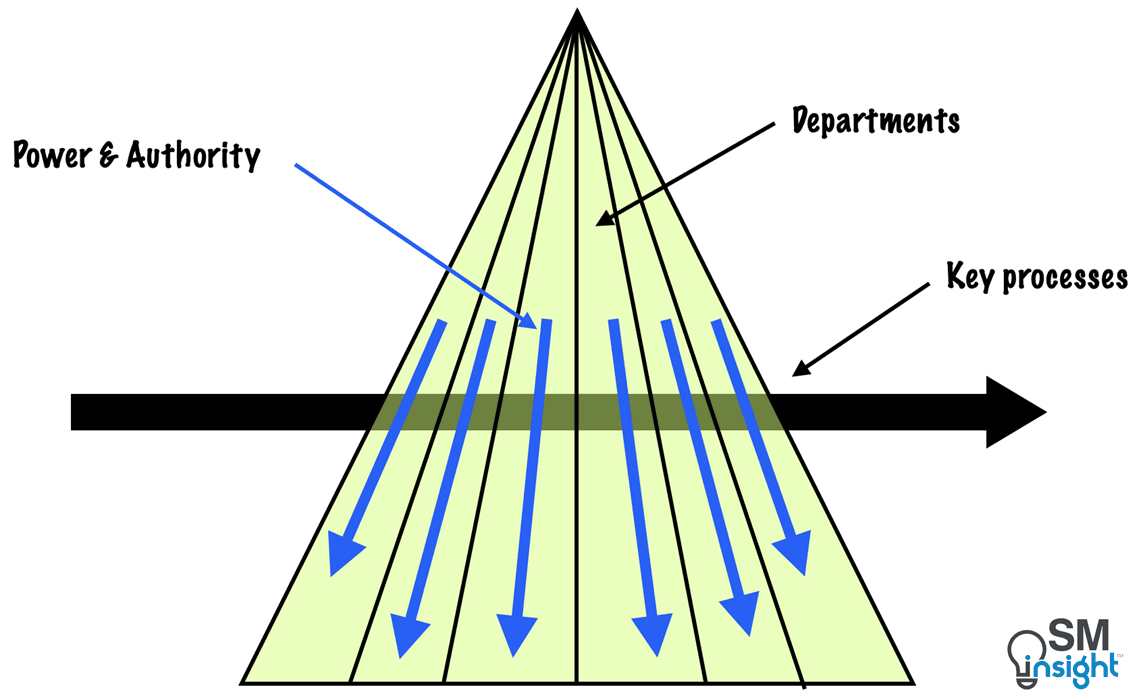
Hoshin Kanri demands a very different approach. It looks at the organization as a community with common objectives and aims to align the entire organization and its efforts toward these objectives:
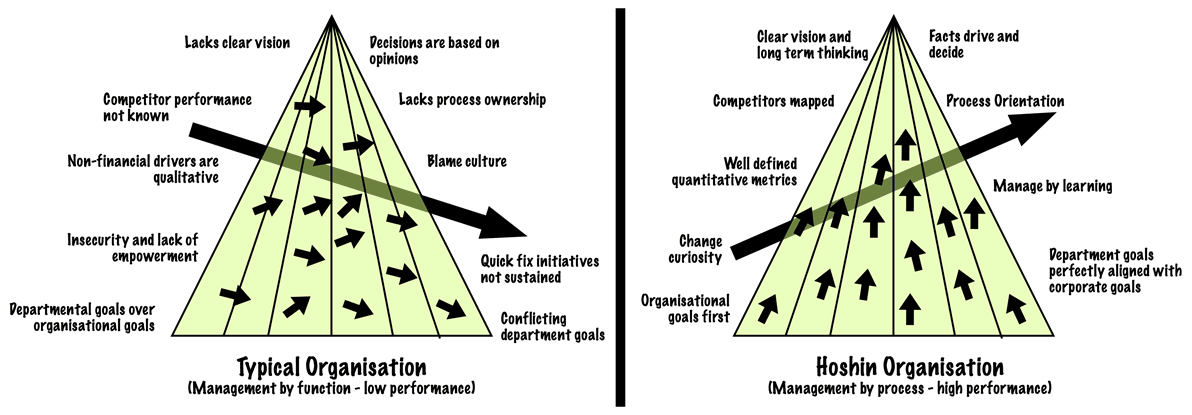
Seven Characteristics of a Hoshin Organization
Organizations that have successfully implemented Hoshin Kanri exhibit seven characteristics, each of which is reflected in their operations and the way they work [2]:
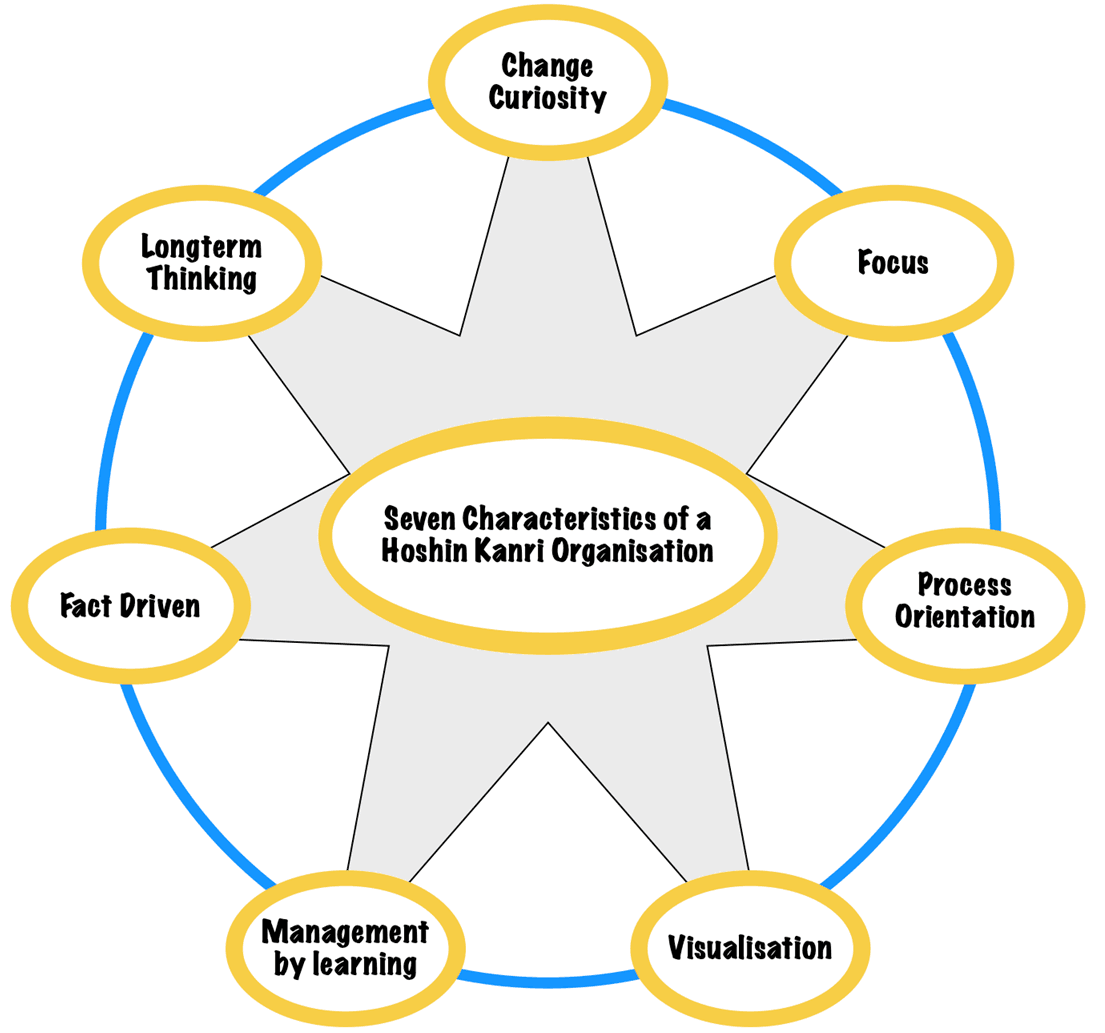
1. Long-term thinking
Every organization has a purpose, a driving force that explains its existence. It aims to create value for its stakeholders (owners, customers, employees, or society). It also aims to be profitable, be the best at what it does, and so on—which is usually referred to as the organization’s vision.
The point of an organization’s purpose and vision is to offer guidance for the future – to guide the strategy work.
A fundamental prerequisite when adopting Hoshin Kanri is a desire to systematically develop the organization toward a clearly formulated and communicated vision that intends to create long-term value.
2. Change curiosity
The key to an organization’s success is its ability to optimize existing work. People constantly seek to develop the organization by optimizing resource utilization.
However, this becomes a problem when organizations become so focused on doing things correctly that they stop questioning if they are doing the correct thing. This limits any possible improvements within tight boundaries.
In Hoshin Kanri, the focus is not only on optimizing the current ways of working but also on challenging and changing the whole way of working. It promotes the desire to be open to change where untried ideas are tested.
Recognizing that not all experiments lead to immediate success, Hoshin encourages people to reflect upon and question the current way of working and thus become innovative. This becomes the basis for organizational learning.
For example, 3M, which practices Hoshin, is famous for its goal that 30% of sales should originate from products introduced less than five years ago. It is seen as one of the most innovative companies in the world [5].
3. Focus
At a strategic level, directing an organization’s energy into too many opportunities seldom leads to success. The key is to concentrate on a few.
Because people believe they should have something to focus on, at every level of the organization, each function focuses on its own small challenge while lacking alignment toward the overall challenge facing the organization.
Hoshin helps organizations establish systematic processes that drive focus, innovation, and success over time.
4. Process Orientation
Process-oriented organizations toning down dependency on individuals to solve problems. They seek to optimize processes regardless of individual variation.
Hoshin promotes establishing processes for addressing problems. This creates a sense of safety in the organization, allows more people to participate in problem-solving, and increases engagement.
In the long run, process-oriented hoshin organizations develop quality-assured solutions that can be implemented quickly. This far exceeds the problem-solving capabilities of an organization that depends on a few “experts.”
Toyota’s success is a testament to the power of process orientation. The company follows a standardized working method that constantly measures, compares, and improves processes to solve problems.
5. Visualization
Visualization means making the organization transparent so that everyone understands their own role and the context in which they work.
Some organizations closely guard their strategy, often taking the “I know something you don’t” approach. Hoshin organizations take the opposite path, inviting employees to participate in strategy work. This leads to better decisions and even better execution.
6. Management by learning
In traditional leadership, the leader distributes and monitors the work. In Hoshin Kanri, the leader’s most important task is to develop and challenge the employees so that they learn more together.
Hoshin accomplishes this using a method known as “Catchball” (discussed later in this article).
Hoshin is based on the notion that an organization’s only unique competitive advantage is its people. Hence, the leader becomes a coach, helping employees address their challenges. It prioritizes the organization and its employees and considers their long-term learning more important than immediately solving current problems.
7. Fact-driven decision-making making
In Hoshin Kanri, facts serve as the point of departure – a fundamental starting point for developing experiments that address clear and well-defined challenges.
Facts serve two objectives:
- They accurately describe the current condition, without which organizations cannot prioritize challenges or evaluate actions.
- They help create consensus. When descriptions are not based on facts, they can easily be considered subjective and not credible.
Because Hoshin organizations value facts, they are better positioned to address challenges.
Implementing Hoshin Kanri
Hoshin Kanri promotes companywide quality control and continuous improvement. It is based on the Plan-Do-Check-Act (PDCA) control method [6] and goes far beyond typical strategic planning.
The seven steps in Hoshin Kanari can be understood through the PDCA cycle as follows:

1. Develop a strategic vision
Creating a vision is an important first step in the strategic management process. This unique vision must stem from the company’s purpose [7] and must be easy to understand and clear in its intent.
Crafting a strategic vision is an iterative process that results in a statement shared by the top management and collectively accepted and understood throughout the organization at all levels.
Learn how to craft a compelling vision statement here [8].
2. Decide the company’s long-term objectives
Long-term objectives, also known as breakthrough objectives, are the vital changes needed to realize the organization’s vision. Because these are big-picture goals (spanning 3-5 years) with many moving pieces, it is good to keep this list short—typically between two and five.
Long-term objectives move the organization from its current condition toward its ambitions. Some of the macro factors to be considered when setting long-term objectives are:
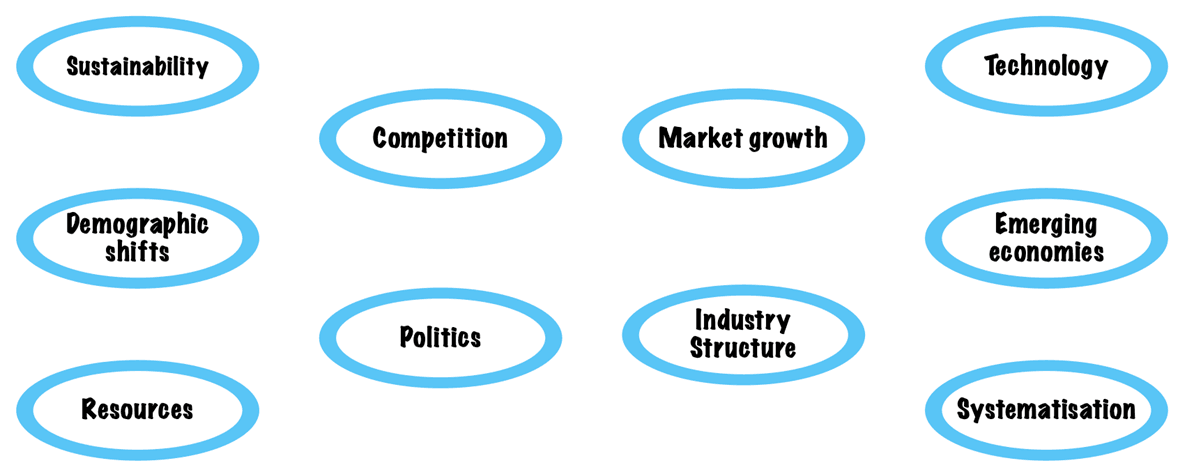
Here are some points of caution when setting long-term objectives:
- Start by inspecting the organization’s current conditions and internal factors—discover what problems exist and what should be done.
- Plans and objectives that are mere extensions of past performances and trends will likely be of little value.
- Regardless of the plan’s seeming validity or the time frame, it is important to clarify expectations. These expectations should result from a thorough analysis of critical problems, current capabilities, and changes outside and inside the company.
3. Extract annual objectives from the long-term goals (Catchball)
To establish annual objectives, follow the following steps:
- Identify opportunities for the next 6 to 18 months.
- Prioritize, analyze, choose, and record high-impact opportunities.
- Establish contribution targets for results.
- Establish annual targets for process improvement.
- Study interdependence (See X-matrix in this article).
- Assign teams for each tactic and provide accountability.
In Hoshin Kanri, going from the long-term visionary target condition to the one-year planning cycle is part of a broader goal dissemination process known as “Catchball” [9].
Catchball is the process of linking challenges to objectives, which are then linked to activities and translated into new challenges. This process continues back and forth across the organizational hierarchy till the final goals and targets are shaped.
It is an iterative process of communication and negotiation that helps ensure everyone participates and owns the strategy work:
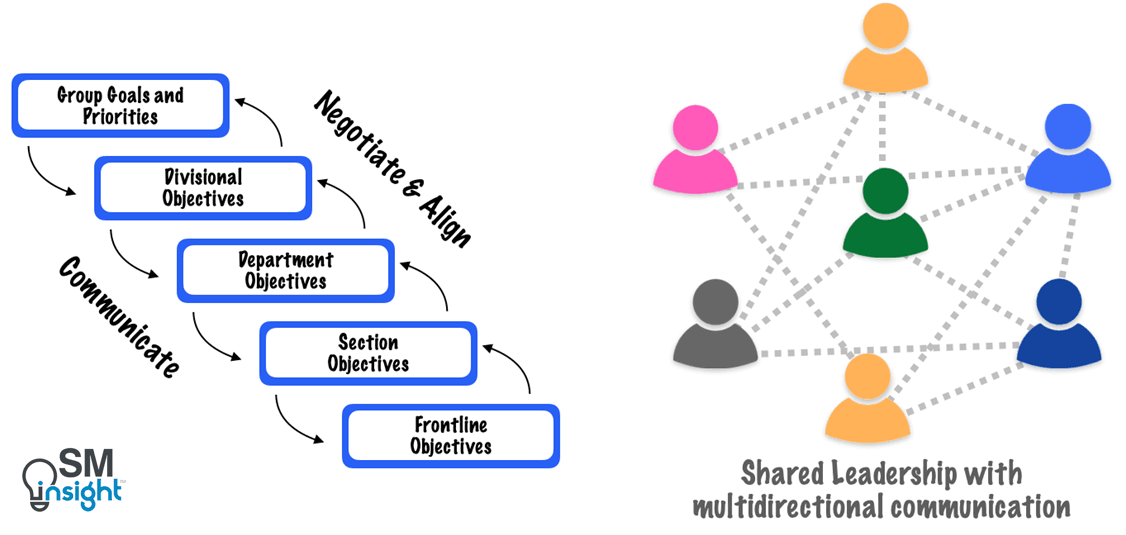
Through this Catchball approach, Hoshin Kanri seeks to develop systems that break down linear communication flows and allow for bottom-up, top-down, horizontal and multi-directional communication about targets, means, and their progress.
4. Develop Drivers and Control Measures
It’s the drivers that make objectives happen. Some of the important drivers to consider are:
- Customer—In Hoshin thinking, everyone downstream from the previous operation in a process is the customer of that activity. Hence, customers can be both internal and external. However, it is particularly important to consider how to attract new (external) customers and document performance.
- Employee—Business success depends upon using all employees’ collective thinking power and job knowledge. Ask how well the organization is doing in this area. Are the competitors doing better? How do we know?
- Suppliers—Because most businesses outsource over 50% of their goods and services, a significant proportion of quality depends on supplier capabilities. How well do we manage suppliers? Do suppliers fully understand our (and our customers’) needs? How did we select suppliers? How do we access their capabilities and performance?
- Processes—What customers receive results from complex interactions across several processes. Problems result from poorly managed interfaces between activities and support functions. Identify major processes and their interfaces. Develop metrics to monitor efficiency.
- Technology—is technology used to its optimum potential? Using the latest technology may not always be beneficial. What metrics tell if technology enables efficient planning, execution, and continuous improvement? How do we measure?
- Finance—Management accounting and cost control have always been the most important parameters for business management, and they remain crucial to success.
- Design and innovation—This driver is concerned not only with the design and innovation of the products and services but also with the design and innovation of processes, operational methods, and everything else that might give rise to a competitive advantage.
For example, at one point, Toyota generated 26 million improvement suggestions annually from a payroll of just 40,000 people! [10].
Develop Key Performance Indicators (KPIs) to monitor objectives based on the above drivers. These KPIs must also be adapted and customized across process and organization levels.
5. Implement
The essence of Hoshin Kanri is that people should work on activities that are vital to strategic success. This is not simply a question of how a vital few programs are deployed but also how they are managed daily.
The principles of Total Quality Management (TQM) [11] and its tools provide a good way to ensure effective process implementation.
6. Monitor
This ensures KPIs are on track for identified drivers and that objectives are achievable. New processes must be considered more carefully as there will be little historical data, and competency may not be guaranteed.
Hoshin Kanri promotes visual management to ensure that there is as little ambiguity as possible about a process’s status. Ideally, at any activity level, it must be clear whether a process is in or out of control.
Some visual management tools for monitoring include:
- Kanban Boards—Visual boards that help teams track tasks, identify bottlenecks, and manage workflow efficiently [12].
- Control Charts—Graphs that display process data over time, highlighting variations and trends to make informed decisions [13].
- Andon Boards—Status-display visualizations used to signal production line issues or bottlenecks. They are a good way for everyone to see the flow status and stoppages throughout the day [14].
- Value Stream Maps—Illustrate activities that add value to the customer, aiding in identifying non-value-adding processes for elimination [15].
7. Conduct an in-depth review
Hoshin teams must review the company’s performance figures from the previous year to discover any critical gaps between actual performance and stated goals. This also means reviewing stated or implied assumptions made in business strategy to discover gaps between assumptions on the one hand and changed reality on the other.
The outcome is a list of important problems that are recognized to affect the company’s continued progress toward its vision.
Because Hoshin Kanri is based on the PDCA cycle, “Check” is built into every stage. The table below shows how Hoshin review meetings involve the entire workforce:
| Meeting | Time | Purpose | Responsibilities |
|---|---|---|---|
| Action teams (Operators; project team members) | In real time | Review own performance and conditions of production (use Andon) | – Feedback to supervisors – Problem resolution |
| Daily | Review own performance by means of operator process and project control boards | – Feedback to action team – Exception reporting – Problem resolution | |
| Operations teams (Supervisors and area team leaders; project team leaders) | Daily | Review own performance by means of operator process and team project control boards | – Feedback to action team – Exception reporting – Problem resolution |
| Weekly | Review local performance; interpret priorities; evaluate activities; detect early warning signals | – Feedback to action team – Exception reporting – Problem resolution | |
| Tactical teams (Functional department heads, and cross functional team leaders) | Weekly | Review scorecards, evaluate programs; support resource decisions; explain performance outliers | – Feedback to operations team leaders and members – Exception reporting – Problem identification |
| Monthly | Review scorecards; evaluate strategy execution; support resource decisions; identify cross-functional issues; identify theme; select overall goals and targets | – Feedback to tactical teams Exception reporting – Commitment process | |
| Hoshin team (Functional department heads, cross functional team leaders, value stream managers, product managers) | Quarterly | Review scorecards; evaluate strategy execution; support resource decisions; identify cross-functional issues; identify theme; select overall goals and targets | – Feedback to tactical teams – Exception reporting – Commitment process |
| Annually | Review vision, strategies, tactics, process measures, results | – Define and deploy annual / semi-annual vision |
In addition to the review methods outlined above, Hoshin Kanri has an additional review method known as The President’s Diagnosis.
At the end of every year, the hoshin team, normally led by the company’s president, must personally visit each site to check on the system’s vitality and recognize achievements.
Through this, Hoshin involves the organization’s top leaders in a systematic fitness review resulting from developing new competitive capabilities.
The Hoshin Planning Matrix (X-Matrix)
Hoshin Kanri requires various organizational-level management teams to cooperate in designing the experiments for strategy, tactics, and operations. To identify factors critical to success and their interdependencies and linkages, Hoshin uses a memorandum format known as the X-matrix that visualizes strategy design on a single piece of paper:
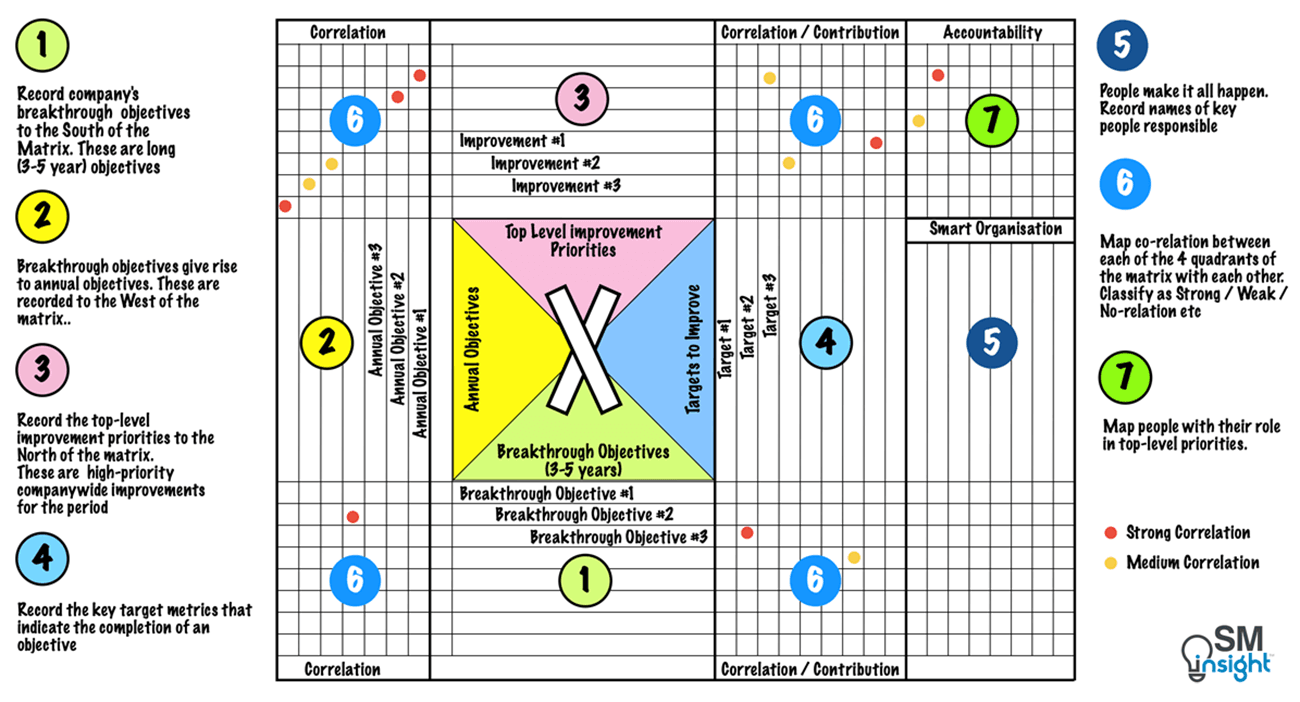
Here are steps to build an X-matrix:
- To the south (bottom) of the matrix, write down the top 2-3 breakthrough objectives. These objectives are derived from the vision; each will have further tasks to achieve the goal. Consider the capacity of your team when identifying these objectives.
- Next, list the organization’s most important annual objectives in the left (west) quadrant of the Hoshin matrix. Also, consider the resources needed.
- Fill the top (north) quadrant with the most important activities the team must complete to achieve the short-term goals.
- To the right (east) quadrant, list the performance indicators based on the target metrics that help track the progress of goals.
- List the key stakeholders responsible for leading the completion of the activities in the matrix’s top quadrant.
- Complete the picture by specifying the dependencies between the listings on the matrix.
Hoshin Kanri is a great tool for linking leadership, teamwork, evaluation, and continuous improvement. Its benefits include integrating strategic objectives with daily tactical management, applying PDCA process management, and improving parallel planning.
Sources
1. “Strategy Deployment”. Lean.org, https://www.lean.org/lexicon-terms/strategy-deployment/. Accessed 05 Feb 2025.
2. “Implementing Hoshin Kanri”. Anders Melander, David Andersson, Fredrik Elgh and Fredrik Fjellstedt, https://www.amazon.com/Implementing-Hoshin-Kanri-Deployment-Improvement/dp/1032048263. Accessed 05 Feb 2025.
3. “Setting, implementing and achieving strategic goals in the insurance industry”. Strategy& (Part of PwC network), https://www.strategyand.pwc.com/de/en/industries/financial-services/smashing-goals/strategyand-setting-implementing-and-achieving-strategic-goals.pdf. Accessed 05 Feb 2025.
4. “Hoshin Kanri – The Strategic Approach to Continuous Improvement”. David Hutchins, https://www.amazon.com/Hoshin-Kanri-Strategic-Continuous-Improvement-ebook/dp/B0C8RNCXLG. Accessed 06 Feb 2025.
5. “The Innovation Mindset in Action: 3M Corporation”. Harvard Business Review, https://hbr.org/2013/08/the-innovation-mindset-in-acti-3. Accessed 06 Feb 2025.
6. “PDCA (Plan-Do-Check-Act)”. Strategic Management Insight, https://strategicmanagementinsight.com/tools/pdca-plan-do-check-act/. Accessed 07 Feb 2025.
7. “Purpose Statement: All You Need to Know”. Strategic Management Insight, https://strategicmanagementinsight.com/tools/purpose-statement/. Accessed 07 Feb 2025.
8. “Vision Statement”. Strategic Management Insight, https://strategicmanagementinsight.com/tools/vision-statement/. Accessed 07 Feb 2025.
9. “Expanding the Purpose of Catchball”. Josh Howell, Lean Enterprise Institute, https://www.lean.org/the-lean-post/articles/expanding-the-purpose-of-catchball. Accessed 07 Feb 2025.
10. “Hoshin Kanri: Policy Deployment for Successful TQM”. Yoji Akao, https://www.amazon.com/Hoshin-Kanri-Policy-Deployment-Successful/dp/156327311X. Accessed 11 Feb 2025.
11. “Total Quality Management”. Strategic Management Insight, https://strategicmanagementinsight.com/tools/total-quality-management/. Accessed 11 Feb 2025.
12. “What Is A Kanban Board? The Ultimate Guide”. Forbes, https://www.forbes.com/advisor/business/software/what-is-kanban-board/. Accessed 10 Feb 2025.
13. “CONTROL CHART”. American Society for Quality, https://asq.org/quality-resources/control-chart. Accessed 10 Feb 2025.
14. “Andon Board”. Six Sigma Daily, https://www.sixsigmadaily.com/andon-board/. Accessed 10 Feb 2025.
15. “Value Stream Mapping (VSM)”. Strategic Management Insight, https://strategicmanagementinsight.com/tools/value-stream-mapping-vsm/. Accessed 10 Feb 2025.
16. “Hoshin Kanri for the Lean Enterprise”. Thomas L. Jackson, https://www.leanuk.org/product/hoshin-kanri-for-the-lean-enterprise/. Accessed 11 Feb 2025.

